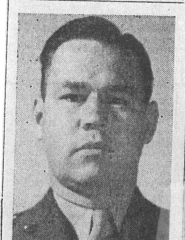William A. Kuretich

William A. Kuretich
WILLIAM
A.
KURETICH
SOLDIER DETAILS
BIOGRAPHY
William Kuretich was born in Hope, KS graduating with honors from Hope High School in 1932. He entered Emporia Teachers College in the fall where Kuretick won honors as an athlete, becoming ce-captin of the football team in 1935. Upon completion of his college career, Kuretich enlisted in the Marine reserves and in the meantime, was hired for a coaching job in Enterprise High School. He worked about a month and relinquished his work when called to duty. In July of 1936, Kuretich entered flight training and received his wings and a commission as second Lieutenant in October 1937. Kuretich served in aircraft squadrons aboard several carriers including the USS Lexington and USS Estes. Early in his career he was stationed in the Hawaiian Islands, an accident happened, resulting in Kuretich losing part of his left hand. He returned to the States to heal, with his next assignment, an instructor at Quantico, VA. From there he was stationed in the Pacific and Okinawa. Participating in Operation Iceberg known as the Battle of Okinawa, the last major battle of World War II. Kuretich, was in charge of controlling U.S. bomber aircraft over the island of Okinawa. “Bombardment is still continuing,” he wrote in his journal from a ship off the Okinawa coast on March 29, 1945. “Weather is like off the California coast. Pretty cold. Saw two planes (ours) run together. Another alert – and a full moon. It looks the same in Kansas.” Kuretich, a U.S. Marine Corps officer, was advised that same year by the military to change his last name so it would have less of an Eastern European sound. He changed it to Kurtis. Another journal entry, “(Japanese) fleet is coming out. From Japan proper. We are up, pretty close to shore – our battleship and cruisers are shelling the preferred beaches – Lots of noise and the smell of gunpowder is prevalent. Some return fire – Also my birthday – thirty-one years old – unbelievable.” THE BATTLE OF OKINAWA was December 1941 to August 1945. It was the largest amphibious landing in the Pacific Theater. More than 280,000 soldiers battled 130,000 Japanese soldiers. In addition, the island had 430,000 civilians living within its towns and villages. The U.S. military needed the air bases on Okinawa as part of the projected invasion of Japan, roughly 350 miles away. When it came time for the bombers to deploy, weather prevented the pilots from hitting their primary target on Okinawa. Kuretich/Kurtis gave them approval to hit a second target. “The secondary target was controversial,” Bill Kurtis remembers his father telling him. “They were to unload their bombs as they flew over their own troops, Army troops who were pinned down on one side of a mountain. “Our artillery couldn’t get to them (the Japanese) because they were protected by the mountain. My dad said, ‘Let’s try it.’ The 15 planes began to circle around the mountain and began delivering their payloads. Every one of those 500-pound bombs hit their target with the exception of the last plane.” That plane’s bomb skipped off the ground and landed in a U.S. Army tent, he said. Fortunately, “it was a dud.” Kuretich/Kurtis remained in the service until 1956, earning the rank of Brig. General. He moved back to Independence, KS living with his wife Wilma, a son, Bill and daughter Jean. More information about William Kuretich/Kurtis in the attached document, courtesy of the Wichita Eagle.
 Eisenhower Foundation
Eisenhower Foundation
